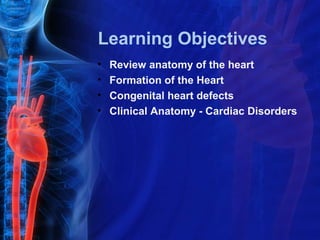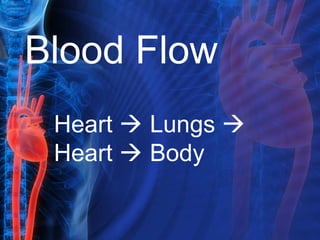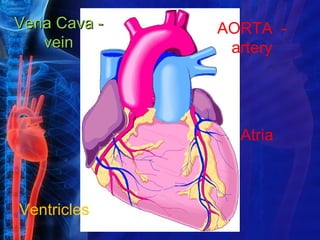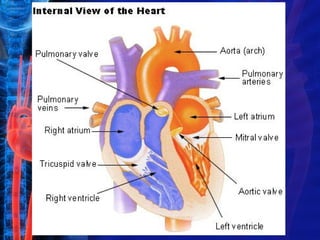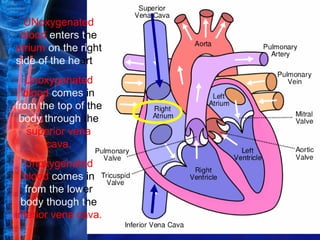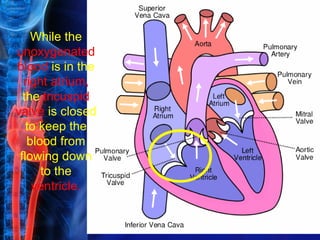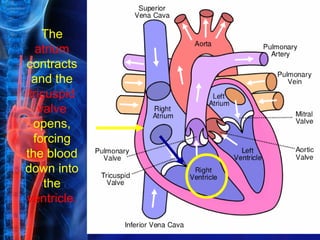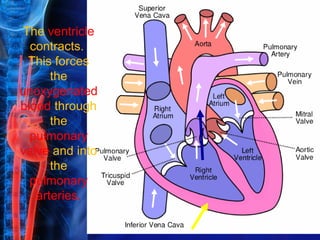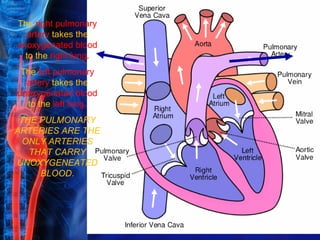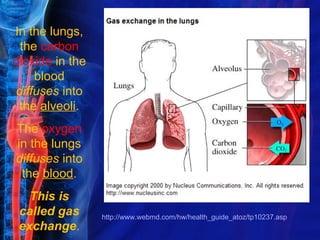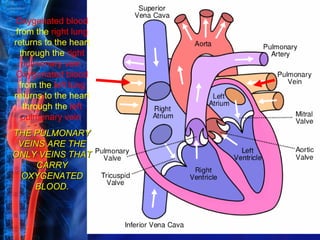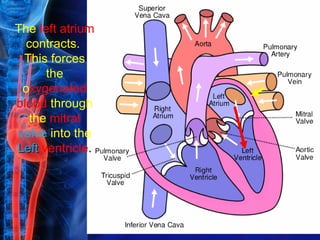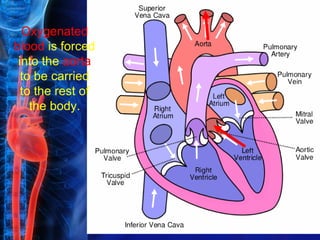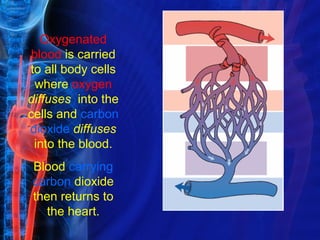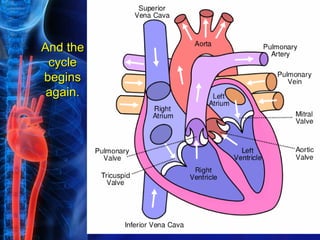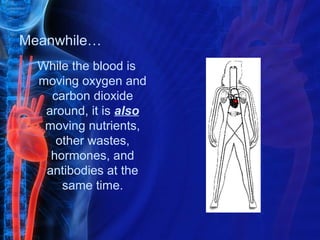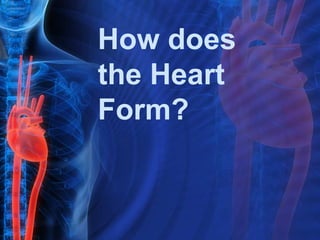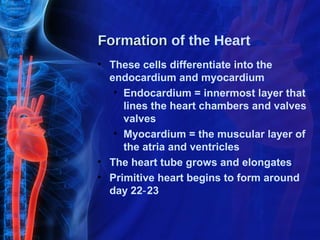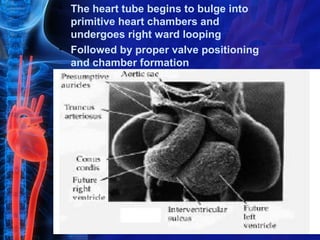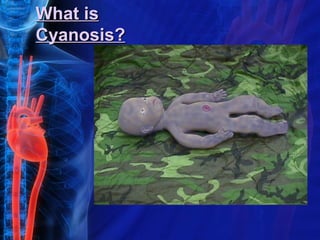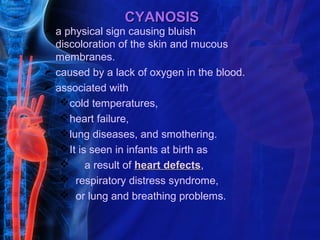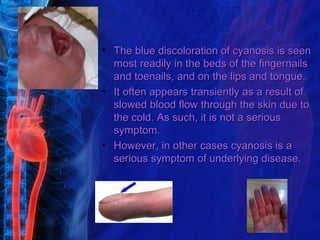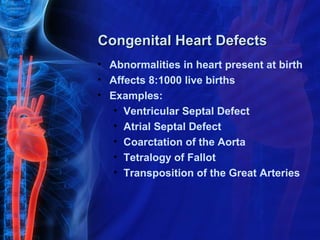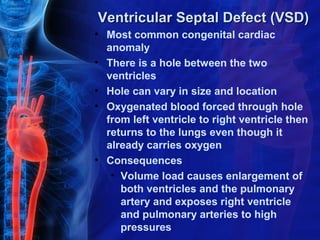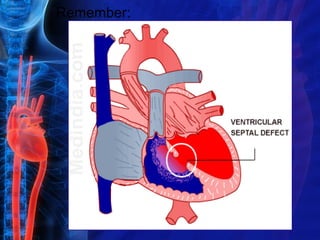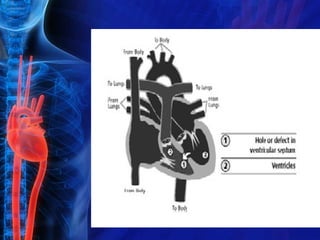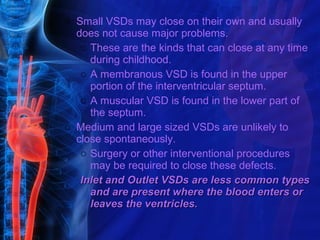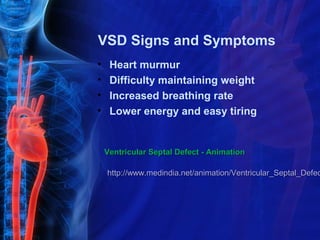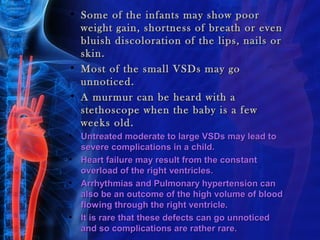Heart lecture 1
- 1. Learning Objectives ÔÇó Review anatomy of the heart ÔÇó Formation of the Heart ÔÇó Congenital heart defects ÔÇó Clinical Anatomy - Cardiac Disorders
- 2. Blood Flow Heart ´âá Lungs ´âá Heart ´âá Body
- 3. Vena Cava - AORTA - vein artery Atria Ventricles
- 5. UNoxygenated blood enters the atrium on the right side of the heart. Unoxygenated blood comes in from the top of the body through the superior vena cava. Unoxygenated blood comes in from the lower body though the inferior vena cava.
- 6. While the unoxygenated blood is in the right atrium, the tricuspid valve is closed to keep the blood from flowing down to the ventricle.
- 7. The atrium contracts and the tricuspid valve opens, forcing the blood down into the ventricle.
- 8. The tricuspid valve closes again so that blood cannot move back up into the atrium.
- 9. The ventricle contracts. This forces the unoxygenated blood through the pulmonary valve and into the pulmonary arteries.
- 10. The right pulmonary artery takes the unoxygenated blood to the right lung. The left pulmonary artery takes the unoxygenated blood to the left lung. THE PULMONARY ARTERIES ARE THE ONLY ARTERIES THAT CARRY UNOXYGENEATED BLOOD.
- 11. In the lungs, the carbon dioxide in the blood diffuses into the alveoli. The oxygen in the lungs diffuses into the blood. This is called gas http://www.webmd.com/hw/health_guide_atoz/tp10237.asp exchange.
- 12. Oxygenated blood from the lungs enters the heart through the left atrium. The mitral valve is closed to keep the blood from going into the ventricle.
- 13. Oxygenated blood from the right lung returns to the heart through the right pulmonary vein. Oxygenated blood from the left lung returns to the heart through the left pulmonary vein. THE PULMONARY VEINS ARE THE ONLY VEINS THAT CARRY OXYGENATED BLOOD.
- 14. The left atrium contracts. This forces the oxygenated blood through the mitral valve into the Left ventricle.
- 15. The mitral valve closes again. This keeps the oxygenated blood from moving back up into the atrium.
- 16. Oxygenated blood is forced into the aorta to be carried to the rest of the body.
- 17. Oxygenated blood is carried to all body cells where oxygen diffuses into the cells and carbon dioxide diffuses into the blood. Blood carrying carbon dioxide then returns to the heart.
- 18. And the cycle begins again.
- 19. Meanwhile While the blood is moving oxygen and carbon dioxide around, it is also moving nutrients, other wastes, hormones, and antibodies at the same time.
- 21. Formation of the Heart ÔÇó Mesoderm divides into two layers ÔÇó Mesoderm = one of the primary germ cell layers in the early embryo ÔÇó Heart precursor cells come from one of those two mesoderm layers (cardiogenic mesoderm) ÔÇó Heart precursor cells form a single heart tube by day 22 of embryogenesis
- 22. Formation of the Heart ÔÇó These cells differentiate into the endocardium and myocardium ÔÇó Endocardium = innermost layer that lines the heart chambers and valves valves ÔÇó Myocardium = the muscular layer of the atria and ventricles ÔÇó The heart tube grows and elongates ÔÇó Primitive heart begins to form around day 22ÔÇÉ 23
- 23. ÔÇó The heart tube begins to bulge into primitive heart chambers and undergoes right ward looping ÔÇó Followed by proper valve positioning and chamber formation
- 25. CYANOSIS ´âÿ a physical sign causing bluish discoloration of the skin and mucous membranes. ´âÿ caused by a lack of oxygen in the blood. ´âÿ associated with ´üÂcold temperatures, ´üÂheart failure, ´üÂlung diseases, and smothering. ´üÂIt is seen in infants at birth as ´ü a result of heart defects, defects ´ü respiratory distress syndrome, ´ü or lung and breathing problems.
- 26. ÔÇó The blue discoloration of cyanosis is seen most readily in the beds of the fingernails and toenails, and on the lips and tongue. ÔÇó It often appears transiently as a result of slowed blood flow through the skin due to the cold. As such, it is not a serious symptom. ÔÇó However, in other cases cyanosis is a serious symptom of underlying disease.
- 27. Congenital Heart Defects ÔÇó Abnormalities in heart present at birth ÔÇó Affects 8:1000 live births ÔÇó Examples: ÔÇó Ventricular Septal Defect ÔÇó Atrial Septal Defect ÔÇó Coarctation of the Aorta ÔÇó Tetralogy of Fallot ÔÇó Transposition of the Great Arteries
- 29. Ventricular Septal Defect (VSD) ÔÇó Most common congenital cardiac anomaly ÔÇó There is a hole between the two ventricles ÔÇó Hole can vary in size and location ÔÇó Oxygenated blood forced through hole from left ventricle to right ventricle then returns to the lungs even though it already carries oxygen ÔÇó Consequences ÔÇó Volume load causes enlargement of both ventricles and the pulmonary artery and exposes right ventricle and pulmonary arteries to high pressures
- 30. Remember:
- 32. o Small VSDs may close on their own and usually does not cause major problems. o These are the kinds that can close at any time during childhood. o A membranous VSD is found in the upper portion of the interventricular septum. o A muscular VSD is found in the lower part of the septum. o Medium and large sized VSDs are unlikely to close spontaneously. o Surgery or other interventional procedures may be required to close these defects. Inlet and Outlet VSDs are less common types and are present where the blood enters or leaves the ventricles.
- 33. VSD Signs and Symptoms ÔÇó Heart murmur ÔÇó Difficulty maintaining weight ÔÇó Increased breathing rate ÔÇó Lower energy and easy tiring Ventricular Septal Defect - Animation http://www.medindia.net/animation/Ventricular_Septal_Defec
- 34. ÔÇó Some of the infants may show poor weight gain, shortness of breath or even bluish discoloration of the lips, nails or skin. ÔÇó Most of the small VSDs may go unnoticed. ÔÇó A murmur can be heard with a stethoscope when the baby is a few weeks old. ÔÇó Untreated moderate to large VSDs may lead to severe complications in a child. ÔÇó Heart failure may result from the constant overload of the right ventricles. ÔÇó Arrhythmias and Pulmonary hypertension can also be an outcome of the high volume of blood flowing through the right ventricle. ÔÇó It is rare that these defects can go unnoticed and so complications are rather rare.

